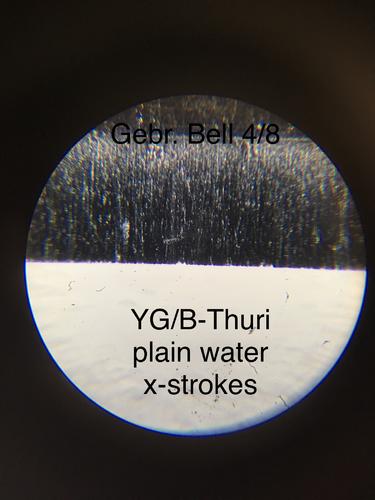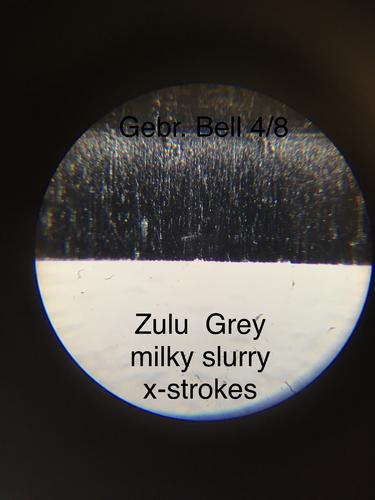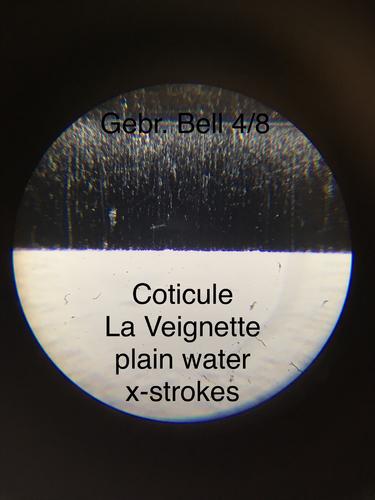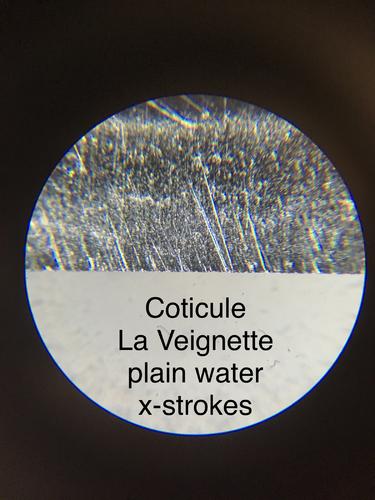Results 1 to 10 of 13
Thread: Coticule after other finisher?
-
01-03-2019, 10:20 PM #1Senior Member

- Join Date
- Nov 2016
- Location
- Germany
- Posts
- 111
Thanked: 30 Coticule after other finisher?
Coticule after other finisher?
Hi all,
I have tried out a couple of coticules in the past months but never beeing able to refine the edge on a coti beyond a solid HHT3. Unicot has worked to me but I don’t like using tape.
Have ended up in using other finishers after wofking on coti.
But recently I‘ve run some x-strokes on my La Veignette with my testing-razor already finished on a YG/B-Thuri. After about 50 of my possible-lightest strokes I‘ve had a look to the edge at my microscope (160x) and have seen lots of Thuri scratches were polished of by coticule!
I‘ve done another set of x-strokes (50 or so) any have seen further refinement. In addition I could see the very apex line has changed its topology a little bit. I would not say the edge line got straightened out or got more rougth, I would just call it „changed“... So I‘ve stopped there, stropped the edge on linen and have got HHT5 (silent slicer)!
Have repeated the same procedure on one of my shaving-rotation-razors which was finished by Zulu Grey and again: after about 100-120 lightest x-strokes the bevel got super-polished (at least my microscope was not able any more to resolve the refined scratch pattern) and the edge line has slightly changed its form. Again HHT5 after linen stropping! Test shave was suuper keen and close, very smooth to the skin.
I guess this polishing is happening when the edge is gliding over the garnets which are embedded in the stone surface. I was astonished to see the polishing level!
Have you tried out to go back to Coticule after another finisfers?
Regards
Philipp
-
01-04-2019, 01:24 AM #2Senior Member



- Join Date
- Feb 2015
- Location
- Duluth, GA - Atlanta OTP North
- Posts
- 2,546
- Blog Entries
- 1
Thanked: 315
Interesting. How many of the lightest possible strokes are you doing prior to moving to the coti?
- Joshua
-
01-04-2019, 01:59 AM #3Senior Member

- Join Date
- Nov 2016
- Location
- Germany
- Posts
- 111
Thanked: 30
Hi Joshua,
before I went to coti the edge of each tested razor was finished by feeling and HHT test. I don’t exactly count the stokes, normaly I do a set of 20-40 strokes, strop the edge on linen, test for keeness and go back to the stone if needed. My skin requires at least a solid HHT4 at the thinnest testing hair.
On Thuringian its way less compared to the Zulu Grey, on the Zulu its usually more than 100 strokes. Also when I use my shallow finisher one stroke does not cover the whole blade so I need 2-3 strokes to run from toe to tip.
-
01-04-2019, 02:04 AM #4Senior Member

- Join Date
- Sep 2018
- Location
- Palm Harbor Fl
- Posts
- 373
Thanked: 49
Get the hardest sharpest edge. And then see how many laps get the edge where you like it. On the coti that is Work it down in stages. Try edge trailing strokes as well. Until you dial it in.
-
01-04-2019, 02:18 AM #5

I've noticed on certain coti's, they can't really "progress" an edge. Typically, bringing them to an 8k edge or higher helps them polish the edge.
-
01-04-2019, 03:27 PM #6

Keep doing exactly what you are doing! With results like that you don’t get much better especially if the shave results match and it is a smooth, sharp and wonderful shave!!
I have done the same with other stones. My guess was that they were much finer than originally expected and therefore it was a larger gap in the progression than originally thought. After closing that gap with another finisher they brought it to the next level.
Again, with results like you are getting don’t change anything except for fun and science. Thanks for sharing your success.What a curse be a dull razor; what a prideful comfort a sharp one
-
01-05-2019, 05:21 PM #7Senior Member

- Join Date
- Nov 2016
- Location
- Germany
- Posts
- 111
Thanked: 30
Thanks a lot for your replies.
I've done further investigations in this topic.
Seems like my La Veignette on plain water does indeed polish the scratches deom my Thuri as well as from my Zulu Grey.
It does also change the very apex of the edge.
Here are some pics in 160x magnification (sorry, my optical system makes pics only usable in the middle of the frame):


Now after those super light strokes on Coti, see how the form of that micro-micro-chip in the middle of the edge has changed its form...
The light source is located for all pictures at the left of the frame to make the scratches visible.

BUT: Seems like as soon as the Coti releases some garneds (autoslurry) into the water they start creating much coarser scratches.
Here is a sample picture, the diagonal scratches were comming from the same coti on plain water.

I am quite sure the more loose garneds in the water while finishing the higher the "slurry dulling" effect occures.
Think my La Veignette does autoslurry relativeley easy, perhabs if the edge is not refined up to a certain level its rughthness causes the coti to autoslurry much more.
How can I prevent my coticule from releasing those garnets?
Do you know some techniques beside to finish under running water? (my free hand finishing is not yet that consistent compared to honing on the bench)
Thanks a lot in advance
Regards
Philipp
-
01-06-2019, 01:03 AM #8

To combat this, I usually rinse the stone under the faucet once I hear/feel some loose bits rolling around. Usually around 20 laps.
My sprayer isn't quite as effective in clearing them off the stone
-
01-06-2019, 02:33 AM #9

Lately I've been honing on oil with great results
-
01-09-2019, 08:54 PM #10Senior Member



- Join Date
- Dec 2014
- Location
- Virginia, USA
- Posts
- 2,224
Thanked: 481
Bouncing off this, as you can see, many (more? ) coticules are prone to auto slurry. The fact that the garnets are loose an prone to break out of the bonding material makes them very fast, an quite versatile for a natural stone. The downside is that should a larger garnet break loose, you're going to end with an edge that is disappointing to shave with.
I might suggest you try honing under running water. You can't stop the stone from auto slurrying, but you can wash the slurry away to minimize the damage it does.
I have to use my coticule with a 50/50 mix of mineral oil and mineral spirits to thin it out and use very light pressure. Otherwise the particulate it releases can degrade an 8K edge. When the stone wants to cooperate it is a good finisher. When it doesn't, I seriously consider relegating it to working on chisels and knives.


 17Likes
17Likes LinkBack URL
LinkBack URL About LinkBacks
About LinkBacks






 Reply With Quote
Reply With Quote

